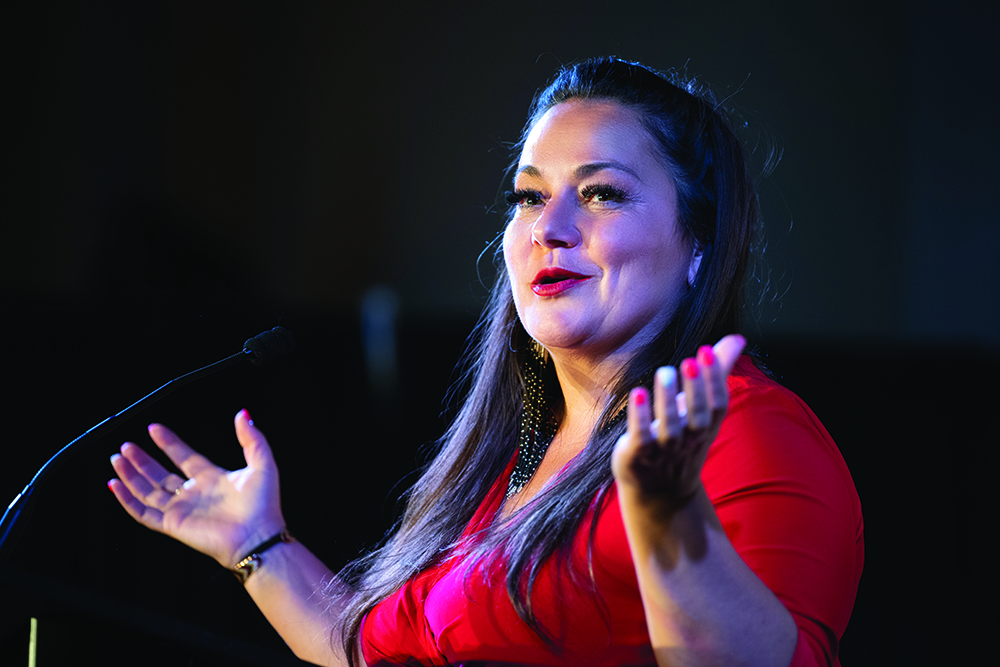
Mandy Buss [B.Sc./03, MD/09], proud descendant of a greatgrandmother who was a traditional Métis midwife, is president of the Indigenous Physicians Association of Canada.
In 2011, Buss was one of the first doctors to complete a family medicine residency through UM’s northern remote program. In 2018, she was appointed the first Indigenous health lead for the department of family medicine.
She recently won a Certificate of Merit Award from the Canadian Association for Medical Education. But the Métis physician from Beausejour, Man., doesn’t think of herself as a trailblazer.
Buss, assistant professor of family medicine, says the department has supported her educational vision, which includes Elder teachings, sharing circles and other traditional teaching tools.
During her undergraduate studies at UM, she recalls, the Access Program, which provides holistic support to Indigenous students, gave her a vital sense of belonging and community. And throughout her medical education and career, Elders and mentors have blazed a trail for her.
“There’s a teaching that when you’re the first person to walk through deep, fresh snow, it’s really hard,” she says. “But once you do, someone can follow your footsteps. And then over time, lots of people walk that path, and then it’s easy to walk on.
“I certainly wouldn’t say I was the first one to walk through that snow. I’ve just picked up the bundle and kept walking, so it’s even easier for the people who come behind me. Maybe I can make the path a little wider, so more people can fit on it.”
Buss practises and supervises residents at a Winnipeg teaching clinic, Northern Connection Medical Centre. We asked her three questions.
Why is it important for Indigenous patients to have access to Indigenous doctors?
Health care has been a very violent, unsafe space for Indigenous people, and it’s always been imposed on them, never with them. An Indigenous physician often has a better understanding of Indigenous patients’ lived experience and the community context.
Not all my Indigenous patients use traditional ways, but they can talk to me about that without feeling like they’re going to be judged. If they have experienced racism in the health-care system, they can tell me, and I believe them.
The other day, I had a patient on the phone who said, “I’m going moose hunting. Do you want some moose?” They know I like to make moose tourtière. That’s the kind of understanding and connection we have.
You direct the Indigenous health curriculum for undergraduate medical students. What do students need to learn?
They need to understand how colonization has led to Indigenous people having the poorest health outcomes today. They need to understand that not all Indigenous communities are the same. They need to unpack stereotypes, and they need to look inward and self-reflect.
We all come into medicine to do good things. But we don’t always recognize when our good intentions are actually harmful for a certain group. What are our blind spots?
Health disparities are a product of racism. How do we use our power and privilege as doctors to interrupt racism and be advocates?
What would you tell all health professionals about providing safe care for Indigenous patients?
Offer an Indigenous patient the same options as any other patient. I had an Indigenous patient who had an amputation. She was never even offered a prosthetic limb. The assumption was that she would not be able to handle it.
We see this with Indigenous patients who have kidney failure and are never offered a kidney transplant or peritoneal [at-home] dialysis. It’s assumed that they won’t be compliant or won’t be able to manage.
Give Indigenous patients time. Make them feel human. Listen to their stories. Treat everybody who walks in the door as if they were your brother, sister, mother or cousin.
BY ALISON MAYES
